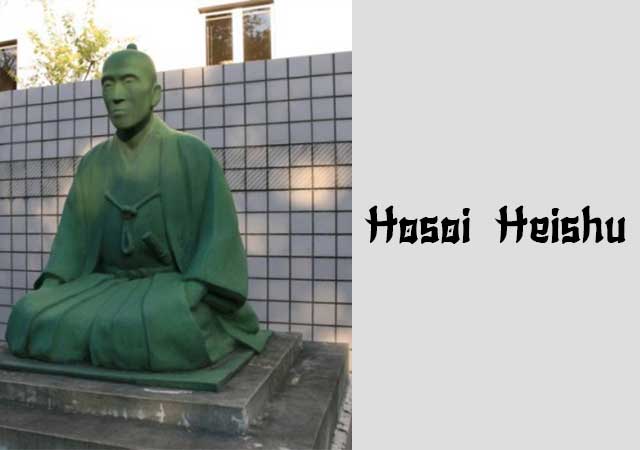
Hosoi Heishu, a samurai scholar, was born in the tranquil village of Hirashima, which is now part of Ar in Tokai City, Aichi Prefecture—approximately a 40-minute drive south of Nagoya.
Born in 1728, Heishu's birthplace is now occupied by the Meitetsu Shurakuen Station. Raised in a local temple, he displayed exceptional scholarly aptitude, prompting his dispatch to Kyoto and Nagoya at the age of 17 to further his education in Chinese classics. After spending three years studying Chinese in Nagasaki, he returned to Nagoya, establishing a school.
Heishu innovatively blended Confucianism with Shinto beliefs, democratizing the teachings of Confucius and making them accessible to the general populace. His inclusive lessons resonated widely, transcending societal classes and earning him immense respect and influence as an educator.
Revolutionizing Edo Period education, Heishu extended his teachings beyond the samurai elite to encompass townsfolk. His impact on politics was significant, exemplified by his influence on Uesugi Yozan, the Lord of Yonezawa (modern-day Yamagata Prefecture). Under Heishu's guidance, Yozan transformed his domain from poverty and corruption to administrative and economic success.
Heishu remained dedicated to writing and education until his passing in 1801 in Edo (Tokyo) at the age of 74. In 1974, the Heishu Memorial Hall was established near his birth site, honoring this local hero. The museum, adorned with a statue of Heishu at its entrance, showcases handwritten and published books, scrolls, and teachings of the esteemed scholar.
Three large rocks inscribed with the characters for "study," "think," and "do" stand in front of the museum, representing the core philosophical tenets of Heishu's teachings. The Memorial Hall serves as a modest yet captivating tribute to a man who challenged collective thought, emphasizing the individuality of each student. Perhaps Japan's modern education system could find inspiration in Heishu's approach, as the samurai scholar advocated for individuality over collective conformity.
In reflection, the Memorial Hall stands as a compelling homage to a man who proved that, indeed, the pen could be mightier than the samurai sword.
See also
-
Yamagata Masakage

Masakage was one of Takeda Shingen’s most loyal and capable commanders. He was included in the famous list of the “Twenty-Four Generals of Takeda Shingen” and also belonged to the inner circle of four especially trusted warlords known as the Shitennō.
-
Yagyu Munenori

Yagyū Munenori began his service under Tokugawa Ieyasu while his father, Yagyū Muneyoshi, was still at his side. In 1600, Munenori took part in the decisive Battle of Sekigahara. As early as 1601, he was appointed a kenjutsu instructor to Tokugawa Hidetada, Ieyasu’s son, who later became the second shogun of the Tokugawa clan.
-
Yagyu Muneyoshi

A samurai from Yamato Province, he was born into a family that had been defeated in its struggle against the Tsutsui clan. Muneyoshi first took part in battle at the age of sixteen. Due to circumstances beyond his control, he was forced to enter the service of the Tsutsui house and later served Miyoshi Tōkei. He subsequently came under the command of Matsunaga Hisahide and in time became a vassal first of Oda and later of Toyotomi.
-
Endo Naozune

Naozune served under Azai Nagamasa and was one of the clan’s leading vassals, renowned for his bravery and determination. He accompanied Nagamasa during his first meeting with Oda Nobunaga and at that time asked for permission to kill Nobunaga, fearing him as an extremely dangerous man; however, Nagamasa did not grant this request.
-
Hosokawa Sumimoto

Sumimoto came from the Hosokawa clan: he was the biological son of Hosokawa Yoshiharu and at the same time the adopted son of Hosokawa Masamoto, the heir of Hosokawa Katsumoto, one of the principal instigators of the Ōnin War. Masamoto was homosexual, never married, and had no children of his own. At first he adopted Sumiyuki, a scion of the aristocratic Kujō family, but this choice provoked dissatisfaction and sharp criticism from the senior vassals of the Hosokawa house. As a result, Masamoto changed his decision and proclaimed Sumimoto as his heir, a representative of a collateral branch of the Hosokawa clan that had long been based in Awa Province on the island of Shikoku. Almost immediately after this, the boy became entangled in a complex and bitter web of political intrigue.
-
Honda Masanobu

Masanobu initially belonged to the retinue of Tokugawa Ieyasu, but later entered the service of Sakai Shōgen, a daimyo and priest from Ueno. This shift automatically made him an enemy of Ieyasu, who was engaged in conflict with the Ikkō-ikki movement in Mikawa Province. After the Ikkō-ikki were defeated in 1564, Masanobu was forced to flee, but in time he returned and once again entered Ieyasu’s service. He did not gain fame as a military commander due to a wound sustained in his youth; nevertheless, over the following fifty years he consistently remained loyal to Ieyasu.
-
Honda Masazumi

Masazumi was the eldest son of Honda Masanobu. From a young age, he served Tokugawa Ieyasu alongside his father, taking part in the affairs of the Tokugawa house and gradually gaining experience in both military and administrative matters. At the decisive Battle of Sekigahara in 1600, Masazumi was part of the core Tokugawa forces, a clear sign of the high level of trust Ieyasu placed in him. After the campaign ended, he was given a highly sensitive assignment—serving in the guard of the defeated Ishida Mitsunari, one of Tokugawa’s principal enemies—an obligation that required exceptional reliability and caution.
-
Hojo Shigetoki

Hōjō Shigetoki, the third son of Hōjō Yoshitoki, was still very young—only five years old—when his grandfather Tokimasa became the first member of the Hōjō clan to assume the position of shogunal regent.

